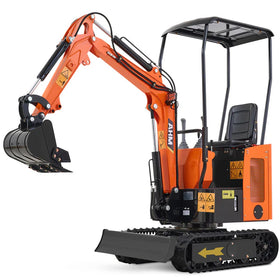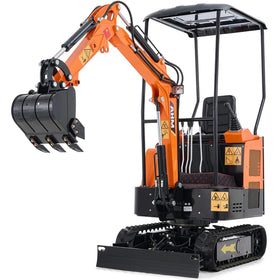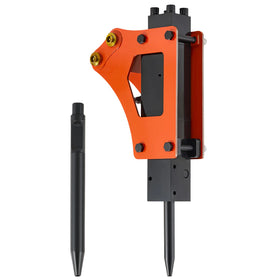A telltale sign of too much oil is that your mower won't start, and the pull cord feels like you're trying to yank a tree stump from the ground. Thick white smoke billows from the muffler the moment the engine catches, and there's oil dripping from places it shouldn't be.
Chances are that if you check the dipstick, you'll find oil halfway up the stick - roughly double what it should be.
Why is Too Much Oil a Problem For Lawn Mowers?
Too much oil in lawnmower engines creates crankcase pressure that can blow gaskets, bend connecting rods, and hydro-lock the cylinder in severe cases.
The small oil pan in push mower engines holds just 15-20 ounces total, leaving almost zero room for error. Overfilling by even 4-6 ounces may lead to heaps of issues, which is why we are here to tell you how to fix this common mistake.

Symptoms of Too Much Oil in a Lawn Mower
Recognizing overfill symptoms early can prevent catastrophic engine damage. Here are some warning signs that will indicate that there is probably too much oil in your lawnmower:
1. White or Blue Smoke From the Exhaust
- Thick smoke billows from the muffler during startup
- Smoke clears within 30-60 seconds as the engine warms
- Light smoking indicates minor overfill (2-4 ounces excess)
- Heavy smoke lasting several minutes indicates a serious overfill
2. The Lawn Mower is Hard to Start, or the Engine is Locked
- The pull cord won't budge or it requires excessive force
- The electric starters can't turn the engine over
- Hydro-lock happens when oil floods the combustion chamber
- The piston can't compress incompressible oil trapped above it
3. Oil Leaking From the Air Filter or Muffler
- The air filter (be it paper or foam) is greasy and appears oil-saturated.
- Oil dripping from the muffler or exhaust ports
- Excess pressure forces oil through the crankcase breather
- Oil travels through the valve train into unexpected areas
4. Engine Overheating
- Excess heat radiates from the engine housing
- Valve springs and rocker arms run hotter than normal
- Can pop valve seats from aluminum engine blocks
5. Fouled Spark Plug
- Spark plug electrode coated with oil
- Black, oily carbon deposits on the plug
- Weak or no spark through the oil film
- Misfires, rough running, or failure to start

How to Fix Too Much Oil in a Lawn Mower
The proper way to fix the issue of too much oil in a lawnmower is to drain the excess lubricant and clean all contaminated components. To achieve this, you can either drain the oil through the oil drain plug, tip the lawnmower to one side to remove the oil, or use a specified oil extraction tool for lawnmowers.
Method #1: Drain The Oil Through the Oil Drain Plug (For Riding Mowers)
Riding mowers and some larger push mowers include drain plugs for easy oil removal. Follow these steps to drain excess oil if you are dealing with a lawnmower that has a drain plug:
- Run the engine 5-10 minutes to warm the oil
- Shut off the engine and disconnect the spark plug wire
- Locate the drain plug on the bottom of the engine near the crankshaft
- Position the drain pan underneath the plug
- Remove plug with appropriate wrench (typically 3/8 inch socket)
- Drain oil until it reaches the proper level (check dipstick frequently)
- Replace the plug and tighten securely
- Refill to the correct level if you drained too much
Method 2: Use the Tip Method (for Push Mowers Without Drain Plugs)
Most modern push mowers lack drain plugs, and the only way to remove excess oil without a specialized tool is to tilt the lawnmower to one side and let the oil drain out.
- Start by identifying which side has the air filter and spark plug, as these must face upward when tipping.
- The dipstick tube should point toward the ground.
Tipping the wrong direction floods the air filter and combustion chamber with oil, making your problem worse.
- Disconnect the spark plug wire
- Empty fuel tank or ensure gas cap is sealed tight
- Position the drain pan next to the mower
- Slowly tip the mower with the air filter/spark plug facing up
- Allow oil to drain through the dipstick tube opening
- Check oil level frequently - don't drain completely
- Return mower to level position
- Recheck oil level and add if needed
Method 3: Use Oil Extraction Tools
Turkey basters, oil extraction pumps, or fluid evacuators can remove small amounts of excess oil. This method works best for minor overfills (2-6 ounces)
- Remove the dipstick completely
- Insert the extraction tube through the dipstick opening
- Pump or suction oil from the crankcase
- Check oil level every 2-4 ounces removed
- Stop when the oil reaches the full mark on the dipstick
- Replace the dipstick and check the level on a flat surface

Always Clean Contaminated Components after Removing Excess Oil
After draining excess oil, take a look at the components affected by overfill. Clean or replace the spark plugs and air filter if required, and burn off residual oil by starting the engine and letting it idle for 3-5 minutes.
The remaining oil in the muffler and exhaust will burn off, giving off smoke that clears as the oil burns away.
Preventing Lawn Mower Overfilling: Correct Oil Capacities
Knowing your mower's exact oil capacity will prevent overfilling. Standard oil capacities differ depending on the type of lawnmower.
Lawn Mower Oil Capacity Chart
| Mower Type | Engine Size | Oil Capacity |
|---|---|---|
| Small push mowers | 140–190cc | 15–20 oz (0.5–0.6 quarts) |
| Large push mowers | 200–250cc | 18–24 oz (0.6–0.75 quarts) |
| Riding mowers (single cylinder) | — | 48–64 oz (1.5–2 quarts) |
| Riding mowers (twin cylinder) | — | 64–80 oz (2–2.5 quarts) |
Too Much Oil in a Lawn Mower Engine: Consequences
The severity of damage caused by too much oil in a lawnmower depends on how much excess oil is in the engine and how long it runs overfilled.
The most common consequences are usually oil foaming and lubrication issues, bent crankshafts/connecting rods, gasket and seal damage, and carburetor flooding. The air filters may also become severely contaminated, which restricts airflow.
1. Oil foaming and lubrication issues
- The crankshaft whips oil into foam like beaten egg whites
- Air bubbles in foam collapse under pressure
- Foaming reduces lubrication properties by 40-60%
- Metal-on-metal contact on bearings and camshaft lobes
- Accelerated wear despite plenty of oil in the crankcase
2. Bent crankshaft or connecting rod
- Severe overfills create enough resistance to bend components
- Forum reports document engines "throwing the crank through the case"
- Single-cylinder push mowers handle minor overfills better than multi-cylinder engines
- Riding mower engines are more susceptible to catastrophic damage
3. Gaskets Get Blown, and Seals are Damaged
- Excess crankcase pressure exceeds gasket design limits
- Head gaskets, valve covers, and crankcase seals leak
- Professional gasket replacement costs $150-300 in repair fees
4. Carburetor flooding and air filter contamination
- Pressurized oil flows backward through the breather system
- Oil enters the carburetor, preventing proper fuel metering
- Saturated air filters restrict airflow
- Rich-running conditions create black smoke

Lawn Mowers with Reliable Oil Systems from AHM
All AHM hybrid mowers feature standard 4-stroke engines with conventional oil systems, making maintenance straightforward.
AHM LM-55 Hybrid Remote Control Mower - $3,399.99
The LM-55's 5 hp 4-stroke OHV engine uses standard small engine oil capacity with easy dipstick access for accurate level checks.
- Engine: 5 hp 4-stroke OHV with standard oil capacity
- Oil type: SAE 30 or 10W-30, depending on temperature
- Fuel consumption: 0.2 gal/h to reduce operating costs
- Easy access: Simple oil fill and dipstick location
- Hybrid system: Battery drive reduces engine load
AHM X80 Hybrid Remote Control Mower - $3,799.99
The X80's 13.6 hp engine provides clear dipstick markings for preventing overfill during routine maintenance.
- Engine displacement: 28 cu. in. (459cc) single-cylinder
- Oil capacity: Approximately 1.5-2 quarts (verify with dipstick)
- Operating hours: 5 hours per tank suggests reliable lubrication
- Air-cooled design: Proper oil level is critical for cooling
Final Thoughts on Excess Oil in Lawn Mowers.
How to fix too much oil in a lawn mower depends on your equipment - drain through the bottom plug on riding mowers, tip push mowers with the air filter facing upward, or use extraction tools for minor overfills of 2-6 ounces. Try to prevent overfills as much as possible, but if it happens, now you know what to do!







